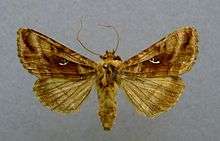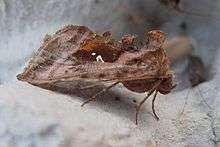Autographa jota
| Autographa jota | |
|---|---|
 | |
 | |
| Scientific classification | |
| Kingdom: | Animalia |
| Phylum: | Arthropoda |
| Class: | Insecta |
| Order: | Lepidoptera |
| Family: | Noctuidae |
| Genus: | Autographa |
| Species: | A. jota |
| Binomial name | |
| Autographa jota (Linnaeus, 1758) | |
| Synonyms | |
| |
The Plain Golden Y (Autographa jota) is a moth of the Noctuidae family. The nominate form is found in Europe.[1] Subspecies Autographa jota anatolica is found in Southern Balkans, South-western Asia, Turkey, the Caucasus, North-western Iran.
Description
The wingspan is 36–44 millimetres (1.4–1.7 in).Forewing pale dull rosy, with olive fuscous shading; a brown spot at middle of base: inner and outer lines nearly straight, edged with brown; median area from inner margin to above middle ferruginous brown; a small V-shaped spot on vein 2 and a small round spot close beyond it pale golden; reniform stigma in part brownish edged; subterminal line suffusedly margined with olive brown, except above anal angle; hindwing fuscous brown, the terminal border darker; in the rarer form percontationis Tr. the two golden marks are coalescent; on the other hand the outer spot, and sometimes both, may be wanting as in the ab. inscripta Esp.; in the form inscripta, from the Baltic provinces of Bussia, the ground colour is much darker, especially in the lower part of the median area; a similar dark form, but with the golden markings confluent as in percontationis Tr., — subsp. [now species Autographa monogramma (Alphéraky, 1887)] monogramma Alph. is met with in Turkestan and the Ussuri district. [2]
Biology
The moth flies from June to August depending on the location.
The larvae feed on the leaves of a wide range of plants, including Urtica, Lamium, Stachys, Galeopsis, Eupatorium cannabinum, Vaccinium myrtillus, Salvia and Senecio.[3]
Subpspecies
There are two recognised subspecies:
- Autographa jota anatolica (Southern Balkans, South-western Asia, Turkey, Caucasus, North-western Iran)
- Autographa jota jota
References
- ↑ "Autographa jota (Linnaeus 1758)". Fauna Europaea. 2.6.2. August 29, 2013. Retrieved December 24, 2013.
- ↑ Seitz, A. Ed., 1914 Die Großschmetterlinge der Erde, Verlag Alfred Kernen, Stuttgart Band 3: Abt. 1, Die Großschmetterlinge des palaearktischen Faunengebietes, Die palaearktischen eulenartigen Nachtfalter, 1914
- ↑ "Robinson, G. S., P. R. Ackery, I. J. Kitching, G. W. Beccaloni & L. M. Hernández, 2010. HOSTS - A Database of the World's Lepidopteran Hostplants. Natural History Museum, London.".